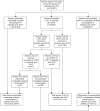Provision of Moderately and Highly Effective Reversible Contraception to Insured Women With Intellectual and Developmental Disabilities
- PMID: 30095771
- PMCID: PMC6105436
- DOI: 10.1097/AOG.0000000000002777
Provision of Moderately and Highly Effective Reversible Contraception to Insured Women With Intellectual and Developmental Disabilities
Abstract
Objective: To estimate provision of moderately and highly effective reversible contraceptives to women with intellectual and developmental disabilities.
Methods: We used data from the Massachusetts All-Payer Claims Database to identify women aged 15-44 years with and without intellectual and developmental disabilities who were continuously enrolled in a private commercial insurance plan, Medicaid, or Medicare in 2012. We calculated the percentage of women aged 15-44 years who were not medically or surgically sterile and were provided 1) highly effective, long-acting reversible contraception (LARC, the intrauterine device or subdermal implant); or 2) prescriptions for moderately effective methods (pill, patch, ring, shot, or diaphragm). Logistic regression models estimated the odds of LARC and moderately effective method provision by disability status, adjusted for age, income, and Medicaid receipt.
Results: Among 915,561 women who were not medically or surgically sterile, 13,059 women (1.4%) had at least one intellectual and developmental disability. Women with intellectual and developmental disabilities were less likely to be provided LARC (2.1% vs 4.2%, P<.001, adjusted odds ratio [OR] 0.43, 95% CI 0.38-0.48, P<.001) and moderately effective methods (21.1% vs 29.9%, P<.001, adjusted OR 0.68, 95% CI 0.65-0.71, P<.001) than women without intellectual and developmental disabilities. The one exception was the progestin shot, which was provided more often to women with intellectual and developmental disabilities than women without these disabilities (14.7% vs 4.3%, P<.001). Among a subset of women who only received moderately effective methods or LARC (n=310,344), women with intellectual and developmental disability had lower odds of receiving LARC than moderately effective methods (adjusted OR 0.59, 95% CI 0.52-0.67).
Conclusion: The study findings raise concerns that the provision of LARC and moderately effective methods differs based on the presence of intellectual and developmental disabilities. Greater understanding is needed regarding factors that underlie lower provision of LARC in comparison with moderately effective methods, especially the progestin shot, among women with intellectual and developmental disabilities.
Conflict of interest statement
The authors did not report any potential conflicts of interest.
Each author has indicated that he or she has met the journal’s requirements for authorship.
Figures


Comment in
-
Contraception for Women With Intellectual and Developmental Disabilities: Reproductive Justice.Obstet Gynecol. 2018 Sep;132(3):555-558. doi: 10.1097/AOG.0000000000002814. Obstet Gynecol. 2018. PMID: 30095755 No abstract available.
References
-
- Centers for Disease Control Prevention. Prevalence and most common causes of disability among adults–United States, 2005. MMWR: Morbidity and Mortality Weekly Report. 2009;58(16):421–426. - PubMed
-
- Bernert DJ, Ding K, Hoban MT. Sexual and substance use behaviors of college students with disabilities. Am J Health Behav. 2012;36(4):459–471. - PubMed
-
- Cheng MM, Udry JR. Sexual experiences of adolescents with low cognitive abilities in the US. J Dev Phys Dsabil. 2005;17(2):155–172.
Publication types
MeSH terms
Grants and funding
LinkOut - more resources
Full Text Sources
Other Literature Sources
Medical

